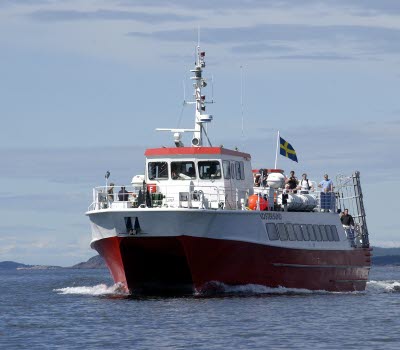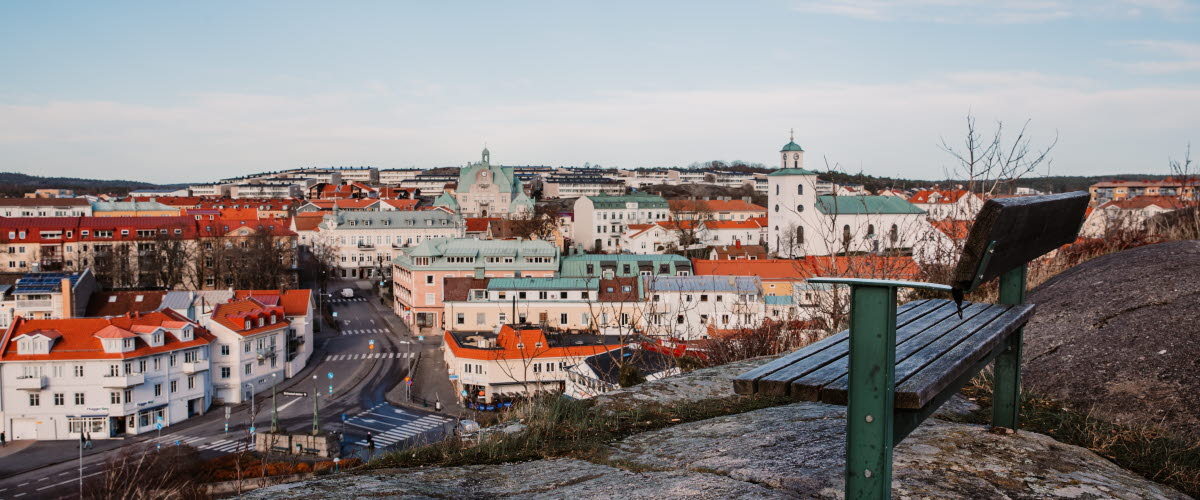The history of Strömstad
Welcome to Strömstad with the Koster Islands – often called Sweden's most westerly outpost. This is where you'll find the saltiest water on the west coast, together with inviting grey granite cliffs. With Strömstad as your base, you can be sure of getting a relaxing and eventful stay. Apart from the amazing archipelago, Strömstad also offers lots of restaurants, good shopping, activities, and Sweden's first marine national park, Kosterhavet. National Park, which opened in 2009. A broad range of places to stay makes it possible to find something to suit every taste.
The river that became Strömstad
Strömstad was founded in the 1500s, by the mouth of the river Strömsån - under the name "Strömmen". This became the foundation for the present day Strömstad.
Timber had long been transported along the river. Both sawn and uncut timber were important commodities. A large number of ships sailed here to buy wood. Once Bohuslän became Swedish, through the Treaty of Roskilde in 1658, the Government in Stockholm became interested in establishing a trading place in the north of Bohuslän. They also wanted to make the new province more Swedish. The Swedish Government had previously passed a law prohibiting trade from all loading places that were not towns. The Government maintained that all trade must be carried out through towns, and therefore the north of Bohuslän must have its own town. It was decided that the new town must be fortified, to help defend the newly won region. When the time came to select a site for the new town, Strömmen's loading place was chosen, probably because of the good harbour and the possibility to build fortifications in the nearby mountains, from which the town could be defended. Strömmen was granted a merchant town charter in 1667, and a town charter soon after.
Strömstad soon made a name for itself as an important shipping town, and during the great herring fishing era, in the second half of the 18th century, trade flourished. Salted herring, dried fish and wood were important commodities and several large merchant vessels had Strömstad as their home harbour. In parallel with an unprecedented herring fishing, the foundations were laid for what was later to become the main symbol of Strömstad; the spa resort Strömstad.
For centuries, Strömstad has been known for its trade. Nowadays, the many visitors during the summer months and the year round cross-border trade between Sweden and Norway mean that Strömstad has an usual number of retail outlets for a town of its size.
Strömstad - an old spa resort
Strömstad is one of Sweden's oldest spa resorts. It's not clear exactly when the first spa visitors arrived in the town, but what we do know is that people were taking the waters at Lejonkällan (the Lion Well) in 1782. The mineral water from the well was thought to cure illnesses like epilepsy, paralysis, rheumatism, etc.
Taking the waters was very fashionable at this time, and to combine outdoor activities with drinking the water was thought to have huge health benefits. In the following century, a number of outdoor and indoor baths were built in Strömstad. These offered shower baths, mud baths, tub baths and seaweed baths. The same treatments are still very popular today, and can be enjoyed in the current indoor spa, built in 1909. The outdoor swimming baths opened in 2005.
Life in a spa resort required summer restaurants and places for cultural entertainment and socialising. The assembly hall Skagerack was built in record time in 1877, when Strömstad suddenly found itself without a hall, due to the great fire which broke out in the town centre the previous year. In the mid-1800s, a restaurant opened on Laholmsudden, a stone's throw from Skagerack. A hotel section was added a hundred years later.
The establishment burnt down to the ground in the 1970s and the current Laholmen Hotel opened in 1984.
Strömstad Badanstalt
The current indoor bathing house was built in 1909. The old outdoor swimming baths, from 1888, was destroyed in a storm in 1968, and later burnt down as part of an exercise with the local fire department.
Kallbadhuset
There is now a new venue for outdoor bathing by Laholmen, in the centre of Strömstad. It opened in June 2005, since when you can enjoy a refreshing morning dip, or a swim whenever you feel like it. This is a great place for swimming and sunbathing! Sun-deck, diving tower, changing rooms and a freshwater shower are available. There is also a sauna – two sauna rooms overlooking the ocean. To have a sauna on a chilly autumn evening, followed by a refreshing swim in the sea is a way to really enhance your quality of life.
Bukten - A historic quarter
Bukten is Strömstads oldest remaining quarter. The buildings here are terraced houses by a cobbled street. Terraced housing was chosen because these were low buildings and offered views over the harbour and boats. They were built during the end of the 18th and the whole of the 19th century. Several of the houses are still permanent residences today. Before the railway was built in the early 20th century, the sea came right up to the dwellings.
Buktegatan is Strömstad's only remaining cobbled street. According to local legend, the women who lived in the houses along the street carried all the stones here. This street was constructed more than 100 years ago. At that time, local residents kept cows and pigs as pets. They had their fields outside of the built-up area. The fields started by the building which is now the library. The vegetable patches were located where the houses opposite the railway station are today, as well as in other sea-facing areas.











